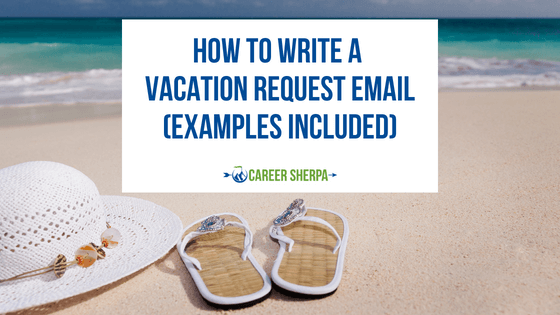Crafting a thoughtful and professional vacation request email is absolutely essential. Not only will it help you get your time off approved, it will also help your employer prepare for your absence.

This guide goes over how to write a vacation request letter that checks all the boxes.
Table of contents
The Importance of Writing a Good Vacation Request Email
Vacation requests are formal letters (usually sent in the form of an email) that outline the specific dates you need off. Most full-time jobs come with vacation time, and companies typically have specific policies about how much time off and when you can make requests.
These emails start the request process. They’re standard practice and help maintain professionalism in the workplace. But it’s not just about formalities. Vacation request emails serve important functions for both you and your supervisor.
First, the email provides clear information about when you want to take time off work for vacation. Having those details in writing is crucial because it eliminates the headache of miscommunication.
Secondly, it prepares your supervisors for your time off.
When someone goes on vacation, it affects everyone. That’s one less person in the office working, and productivity could suffer if your supervisor has to scramble to cover your responsibilities. Vacation request emails give your employer ample notice and time to make arrangements before your vacation.
If you work in an industry that experiences more business during certain periods of the year, you may be unable to take last-minute vacations. Request emails usually have to go through an approval process. By sending a well-written email, you give supervisors all the information they need to prepare.
At the end of the day, writing a professional vacation request email is good for everyone. It can increase your chances of getting the time approved, and lessen the pressure put on your colleagues while you’re gone.
How to Write One
Sending an email to your supervisor to request a vacation doesn’t have to be intimidating. Follow these steps to craft a well-articulated and effective letter that benefits you and your company.
1. Familiarize Yourself With the Vacation Policy
Before sending a letter requesting vacation time, familiarize yourself with company policies. The last thing you want to do is violate policy because you’re uninformed. Doing so could make you look bad and possibly hurt your chances of getting your request approved.
Dive into the employee handbook and review all documentation you received when you accepted your job offer. In most cases, you’ll find policies on vacations and instructions on how to request time away.
If you can’t find any policies or are unclear whether your company even has any regarding vacation time, speak with HR. It’s better to inform yourself before you start making concrete plans. You should know how many vacation days you have and understand any rules about advance notice.
2. Provide Advanced Notice
Always provide advance notice when making vacation requests. How early should you reach out to your supervisor? That all depends on company policy.
As a general rule of thumb, you should provide at least one month of advance notice. If it’s possible to make a request earlier, it’s always better. If there are other people on your team, submitting your vacation request early may put you first in line. The more time you give your supervisor to plan for your time away, the more likely they are to approve it.
3. Try to Pick Well-Timed Dates
Before you start drafting your vacation request email, be strategic when choosing the days you plan on being away. Work around busy times of the year or when you know your company will need to rely on you.
You must remember that vacations affect everyone. You’re entitled to use up your vacation time, but how you use it will impact what employers think of you. Requesting time off during the busiest time of the year isn’t a good look, and it’s possible that supervisors will not approve of your request.
Look ahead and use your knowledge of the company and industry to choose your dates wisely. If you’re unsure, don’t be afraid to reach out to HR or speak with some of your colleagues for their input.
4. Pick a Strong Subject Line
Strong subject lines are crucial for any workplace email. Your supervisor likely receives many email messages a day, and there’s no guarantee that they read them all. To ensure that your vacation request email gets seen, you must provide a direct subject line that immediately lets the reader know what your message is about.
The best approach is to provide your name, a blurb that lets them know the purpose of the email, and possibly the dates you want off.
That sounds like a lot, but it can be the difference between your supervisor reading your email or forgetting about it. The trick is to be short and direct. Leave the more superfluous details for the body of the message.
Here’s a good sample subject line:
[YOUR NAME] Vacation Request [DATE] to [DATE].
5. Make It Clear Why You’re Emailing Them
After a standard greeting, state the purpose of your vacation request email. It should be the first thing your supervisor sees after opening the message. Avoid any unnecessary banter and get straight to the point.
Be professional, direct, and kind.
Don’t make the mistake of treating the vacation request as non-negotiable. You may have some room to negotiate later, but it’s not a good idea to come out of the gate sounding like you''re listing demands.
6. Provide the Dates You’d Like to Have Off
Of course, you also need to provide the exact dates you want to take off for vacation. That information is already in the subject line you wrote, but you need to reiterate it in your email and ensure it matches. Remember: This vacation request email serves as both a request to your supervisor and a written document to detail your history of communication on this matter.
If you’re flexible, don’t be afraid to express that in your email. It can show your willingness to compromise and give your supervisor more options on how they plan for your absence.
That said, you should always put your preferred dates first.
If your company uses an accrued time off model, also express how many hours you plan to use on your vacation. That extra information will make it easier for your supervisor to record those hours and make necessary adjustments to your benefits.
7. Briefly Mention What Your Work Plan Is As It Pertains To Your Vacation
Here’s an important tip that can take an ordinary vacation request email to the next level in terms of professionalism. In addition to providing the dates you want to take off, let your supervisor know what you’re doing at work to prepare for it.
Taking a vacation always presents a risk that you’ll fall behind or that projects will fall by the wayside. Detailing your plans shows that you genuinely care about the success of the company and are doing what you can to ensure that the impact of your absence is as minimal as possible.
You can provide a list of the tasks you’re working on now and what you plan to complete before you leave. It’s also wise to let supervisors know about any outstanding responsibilities they may need to cover while you’re gone. Also, let your employer know you’ve informed colleagues and prepared relevant teams for your time off.
8. Offer to Answer Any Questions They Have
The best way to end your vacation request email is to leave the door open for further questions. Your supervisor may need clarification on a few things, so you must express that you’re willing to discuss this further if necessary. Doing so shows that you’re a good communicator.
It’s also a professional courtesy. Invite your supervisor to reach out to confirm their decision or ask any questions they may have. Don’t forget to thank them for their time, too.
9. Send a Follow-Up
After you receive confirmation and approval, you still need to keep in touch before you leave. It’s a good idea to send a follow-up message a week or two before your scheduled vacation. Things always fall through the cracks, and your employer may forget that you’ll be off.
Sending a follow-up gently reminds them that you’ll be unavailable. Plus, it gives them time to see if there are any remaining tasks they need you to complete before you go. Getting those work responsibilities out of the way will ensure you can enjoy your vacation time without constant back-and-forths with the office.
Example Letters
We have a few examples to inspire you as you write your own vacation request email. Your emails will vary based on your company policy and corporate structure, but you can use these samples to get a better idea of what works.
Example 1
Our first letter is a good, universal template to follow. It checks off all the boxes, is direct, and gives supervisors everything they need to approve the request.
Subject: Janice Smith Vacation Request October 9 – 22
Hello Mrs. Johnson,
I’m reaching out to request your approval for some upcoming time off I want to take. I’m hoping to use my annual vacation time from October 9th to October 22nd. I will return to the office on the following Monday, October 23rd.
I’m currently wrapping up a project for the Anderson account, and I expect to receive the go-ahead for one more before I leave. I will provide all deliverables the week before my leave and inform all colleagues. I’ll have limited access to email during my vacation time but will provide any urgent support during my absence.
Thank you for your time and consideration. Please reach out if you have any additional questions. I look forward to your response.
Sincerely,
Janice Smith
Example 2
Our second example offers a little more leeway for the sender. It’s a more informal request that you can use if you’ve already discussed your plans with your supervisor. In that case, it acts as a written reminder and formal request, providing key details about your plans.
Subject: Time-Off Request for Janice Smith
Hello Jessica,
As I mentioned to you last week, I’m hoping to take some time off in late May to visit my family. I’m formally requesting to use my vacation time between May 29th and June 9th.
Those are my ideal dates, but I have some flexibility if we have important projects planned during that time. Please reach out and let me know what you’re thinking, and I’ll be happy to see what we can do.
During my absence, I plan to be available by email should anything come up or if anyone on the team needs guidance as they cover my work. I’m confident that I will wrap up my current project before then and plan to submit all deliverables early in the week before I leave.
Other than speaking to my clients if they reach out, there shouldn’t be much for my colleagues to do. Based on your approval, I plan to contact my clients and inform them of my time off.
Thank you for considering my request, and please let me know if you need any additional information. As I said, I can move things around if necessary. I look forward to hearing back from you.
Yours Sincerely,
Janice Smith
Example 3
Our final example is another straightforward letter. This employee has already taken care of most of their core responsibilities, leaving little for the supervisor to do. This email works great because it’s simple, to the point, and provides reassurance that productivity won’t decrease while the worker is on vacation.
Subject: Vacation Request for Janice Smith, July 5th to July 21st
Hello Paul,
I’m reaching out today to request some vacation time. I’m planning a trip with my family to Europe for the summer.
I’m asking that you approve my request to use my annual leave from July 5th to July 21st. I will be back in the office on Monday, July 24th.
I plan to speak with my team members about taking time off. I will inform them of some of my client responsibilities and give them access to core documents they would need if those clients reached out in my absence. I also plan to give them contact information to reach me via email and video chat if they need any additional support.
I’m requesting vacation time in early July because it’s the start of our third quarter. I’ll have our second-quarter reports in the week before and can pass off projects to other team members if they come in during those first few days of the new quarter.
That should leave little work to cover until I get back.
Please let me know what you think. I thank you for your consideration of this request and look forward to hearing your decision before I book my family’s cruise.
Thanks for your time,
Janice Smith
We’ve included this last example. As we mentioned in our tips earlier, it’s a good idea to write a quick follow-up email to your supervisor a week or two before you leave. Here’s a good sample email you can use as a template.
Subject: Vacation Reminder – John Smith
Dear Jessica,
I just wanted to remind you that I will be out of the office on vacation from May 29th to June 9th. I will be back to work the following Monday, June 12th.
As we discussed earlier, I’ve left my colleague Rebecca access to my workstation so that she can help any of my clients that might call in. I informed all of my clients that I would be out of the office until June 12th, but they know that they can contact Rebecca for assistance.
Please don’t hesitate to contact me at my work email if you or anyone else on the team needs to reach me. Thank you, and I’ll see you on June 12th.
Sincerely,
John Smith
Conclusion
Vacation request emails don''t need to be fancy. In fact, a simple and straightforward message is usually best!
Simply follow our recommendations when drafting your letter, and you''ll be happy with the results.
The post How To Write A Vacation Request Email (Examples Included) appeared first on Career Sherpa.











